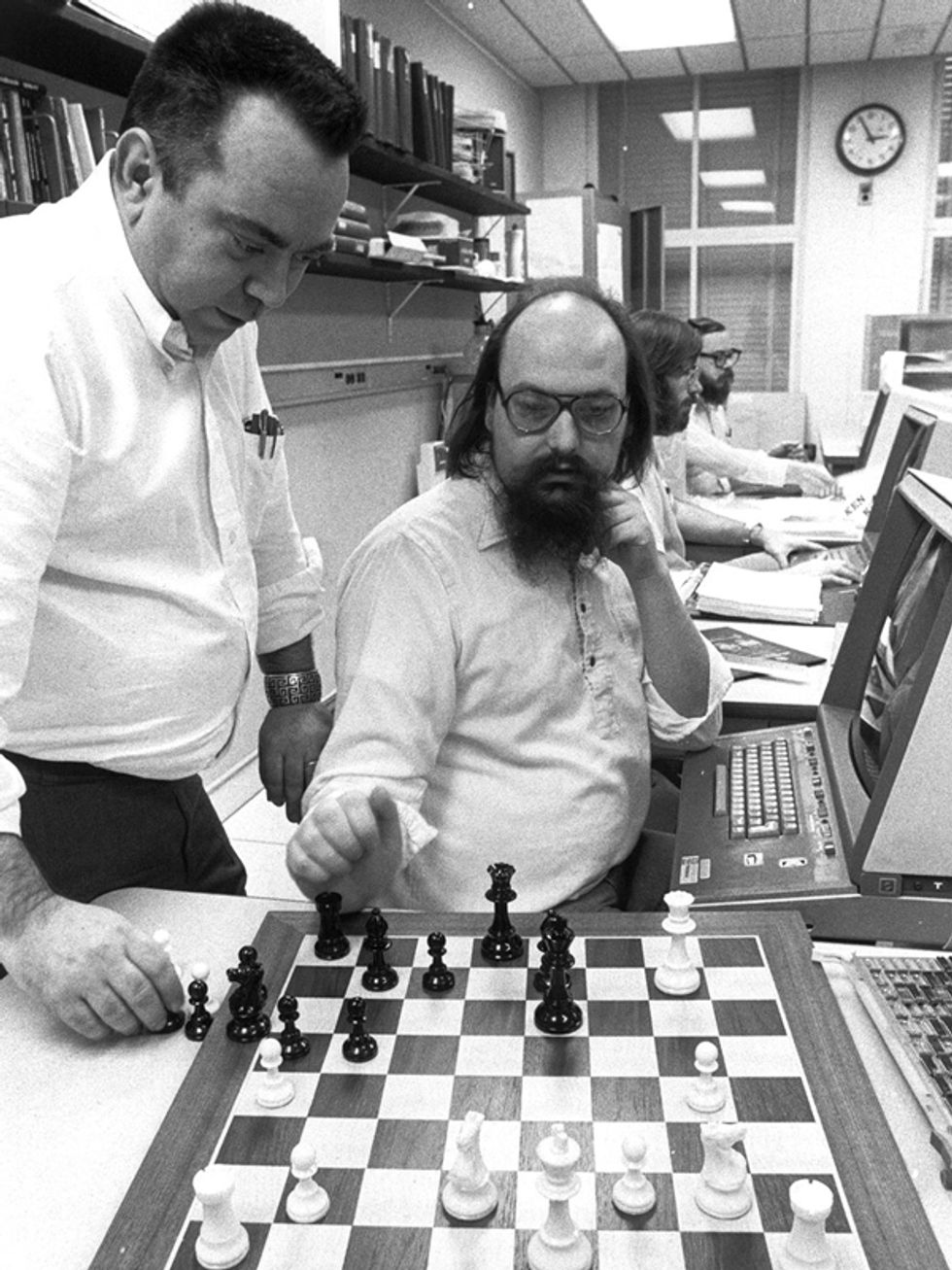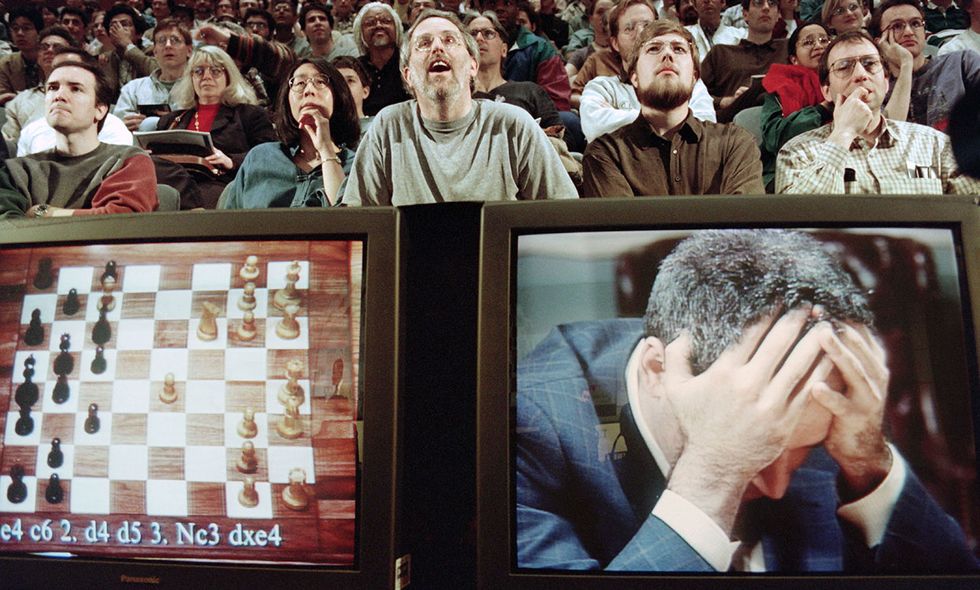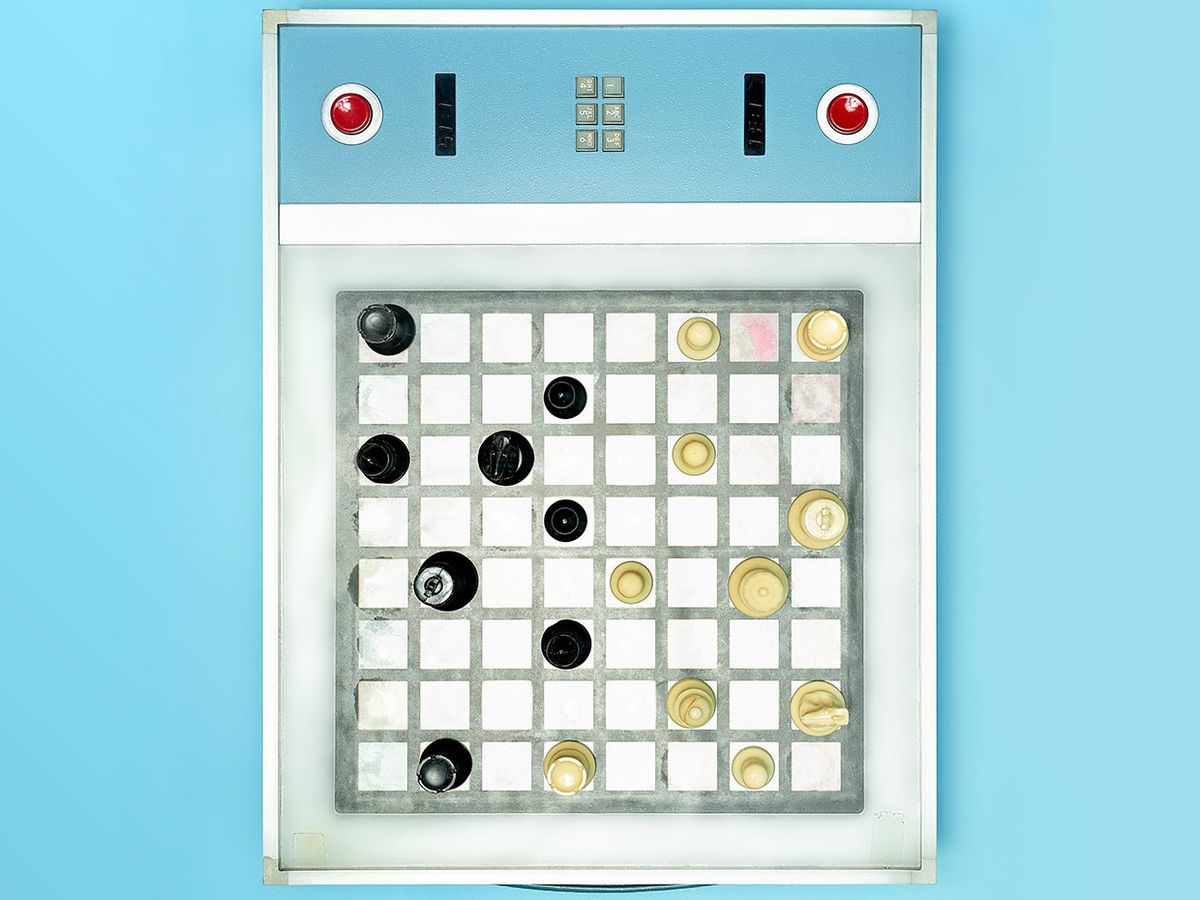Chess is a complicated game. It’s a game of strategy between two opponents, but with no hidden information and all of the potential moves known by both players at the outset. With each turn, players communicate their intent and try to anticipate the possible countermoves. The ability to envision several moves in advance is a recipe for victory, and one that mathematicians and logicians have long found intriguing.
Despite some early mechanical chess-playing machines—and at least one chess-playing hoax—mechanized chess play remained hypothetical until the advent of digital computing. While working on his Ph.D. in the early 1940s, the German computer pioneer Konrad Zuse used computer chess as an example for the high-level programming language he was developing, called Plankalkül. Due to World War II, however, his work wasn’t published until 1972. With Zuse’s work unknown to engineers in Britain and the United States, Norbert Wiener, Alan Turing, and notably Claude Shannon (with his 1950 paper “Programming a Computer for Playing Chess” [PDF]) paved the way for thinking about computer chess.
Beginning in the early 1970s, Bell Telephone Laboratories researchers Ken Thompson and Joe Condon developed Belle, a chess-playing computer. Thompson is cocreator of the Unix operating system, and he’s also a great lover of chess. He grew up in the era of Bobby Fischer, and as a youth he played in chess tournaments. He joined Bell Labs in 1966, after earning a master’s in electrical engineering and computer science from the University of California, Berkeley.
Joe Condon was a physicist by training who worked in the Metallurgy Division at Bell Labs. His research contributed to the understanding of the electronic band structure of metals, and his interests evolved with the rise of digital computing. Thompson got to know Condon when he and his Unix collaborator, Dennis Ritchie, began collaborating on a game called Space Travel, using a PDP-7 minicomputer that was under Condon’s purview. Thompson and Condon went on to collaborate on numerous projects, including promoting the use of C as the language for AT&T’s switching system.
Belle began as a software approach—Thompson had written a sample chess program in an early Unix manual. But after Cordon joined the team, the program morphed into a hybrid computer chess-playing machine, with Thompson handling the programming and Condon designing the hardware.

Belle consisted of three main parts: a move generator, a board evaluator, and a transposition table. The move generator identified the highest-value piece under attack and the lowest-value piece attacking, and it sorted potential moves based on that information. The board evaluator noted the king’s position and its relative safety during different stages of the game. The transposition table contained a memory cache of potential moves, and it made the evaluation more efficient.
Belle employed a brute-force approach. It looked at all of the possible moves a player could make with the current configuration of the board, and then considered all of the moves that the opponent could make. In chess, a turn taken by one player is called a ply. Initially, Belle could compute moves four plies deep. When Belle debuted at the Association for Computing Machinery’s North American Computer Chess Championship in 1978, where it claimed its first title, it had a search depth of eight plies. Belle went on to win the championship four more times. In 1983, it also become the first computer to earn the title of chess “master.”
Computer chess programmers were often treated with hostility when they pitted their systems against human competitors, some of whom were suspicious of potential cheating, while others were simply apprehensive. When Thompson wanted to test out Belle at his local chess club, he took pains to build up personal relationships. He offered his opponents a printout of the computer’s analysis of the match. If Belle won in mixed human/computer tournaments, he refused the prize money, offering it to the next person in line. Belle went on to play weekly at the Westfield Chess Club, in Westfield, N.J., for almost 10 years.
In contrast to human-centered chess competitions, where silence reigns so as not to disturb a player’s concentration, computer chess tournaments could be noisy affairs, with people discussing and debating different algorithms and game strategies. In a 2005 oral history, Thompson remembers them fondly. After a tournament, he would be invigorated and head back to the lab, ready to tackle a new problem.
For a computer, Belle led a colorful life, at one point becoming the object of a corporate practical joke. One day in 1978, Bell Labs computer scientist Mike Lesk, another member of the Unix team, stole some letterhead from AT&T chairman John D. deButts and wrote a fake memo, calling for the suspension of the “T. Belle Computer” project.
At the heart of the fake memo was a philosophical question: Is a game between a person and a computer a form of communication or of data processing? The memo claimed that it was the latter and that Belle therefore violated the 1956 antitrust decision barring the company from engaging in the computer business. In fact, though, AT&T’s top executives never pressured Belle’s creators to stop playing or inventing games at work, likely because the diversions led to economically productive research. The hoax became more broadly known after Dennis Ritchie featured it in a 2001 article, for a special issue of the International Computer Games Association Journal that was dedicated to Thompson’s contributions to computer chess.
In his oral history, Thompson describes how Belle also became the object of international intrigue. In the early 1980s, Soviet electrical engineer, computer scientist, and chess grandmaster Mikhail Botvinnik invited Thompson to bring Belle to Moscow for a series of demonstrations. He departed from New York’s John F. Kennedy International Airport, only to discover that Belle was not on the same plane.
Thompson learned of the machine’s fate after he’d been in Moscow for several days. A Bell Labs security guard who was moonlighting at JFK airport happened to see a Bell Labs box labeled “computer” that was roped off in the customs area. The guard alerted his friends at Bell Labs, and word eventually reached Condon, who lost no time in calling Thompson.
Condon warned Thompson to throw out the spare parts for Belle that he’d brought with him. “You’re probably going to be arrested when you get back,” he said. Why? Thompson asked. “For smuggling computers into Russia,” Condon replied.
In his oral history, Thompson speculates that Belle had fallen victim to the Reagan administration’s rhetoric concerning the “hemorrhage of technology” to the Soviet Union. Overzealous U.S. Customs agents had spotted Thompson’s box and confiscated it, but never alerted him or Bell Labs. His Moscow hosts seemed to agree that Reagan was to blame. When Thompson met with them to explain that Belle had been detained, the head of the Soviet chess club pointed out that the Ayatollah Khomeini had outlawed chess in Iran because it was against God. “Do you suppose Reagan did this to outlaw chess in the United States?” he asked Thompson.
Returning to the states, Thompson took Condon’s advice and dumped the spare parts in Germany. Arriving back home, he wasn’t arrested, for smuggling or anything else. But when he attempted to retrieve Belle at JFK, he was told that he was in violation of the Export Act—Belle’s old, outdated Hewlett-Packard monitor was on a list of banned items. Bell Labs paid a fine, and Belle was eventually returned.
After Belle had dominated the computer chess world for several years, its star began to fade, as more powerful computers with craftier algorithms came along. Chief among them was IBM’s Deep Blue, which captured international attention in 1996 when it won a game against world champion Garry Kasparov. Kasparov went on to win the match, but the ground was laid for a rematch. The following year, after extensive upgrades, Deep Blue defeated Kasparov, becoming the first computer to beat a human world champion in a tournament under regulation time controls.

Photographer Peter Adams brought Belle to my attention, and his story shows the value of being friendly to archivists. Adams had photographed Thompson and many of his Bell Labs colleagues for his portrait series “Faces of Open Source.” During Adams’s research for the series, Bell Labs corporate archivist Ed Eckert granted him permission to photograph some of the artifacts associated with the Unix research lab. Adams put Belle on his wish list, but he assumed that it was now in some museum collection. To his astonishment, he learned that the machine was still at Nokia Bell Labs in Murray Hill, N.J. As Adams wrote to me in an email, “It still had all the wear on it from the epic chess games it had played... :).”
An abridged version of this article appears in the May 2019 print issue as “Cold War Chess.”
Part of a continuing series looking at photographs of historical artifacts that embrace the boundless potential of technology.
About the Author
Allison Marsh is an associate professor of history at the University of South Carolina and codirector of the university’s Ann Johnson Institute for Science, Technology & Society.
Allison Marsh is a professor in Women and Gender Studies at the University of South Carolina and codirector of the university’s Ann Johnson Institute for Science, Technology & Society. She combines her interests in engineering, history, and museum objects to write the Past Forward column, which tells the story of technology through historical artifacts. Marsh is currently working on a book on the history of women in electrical engineering.



